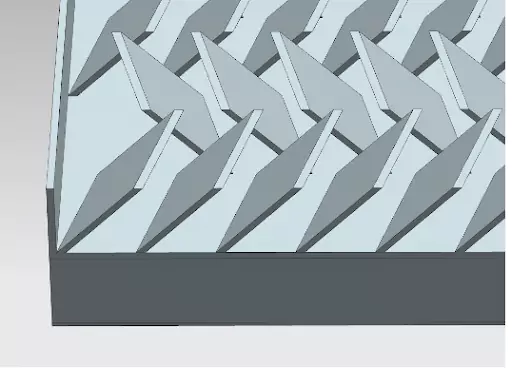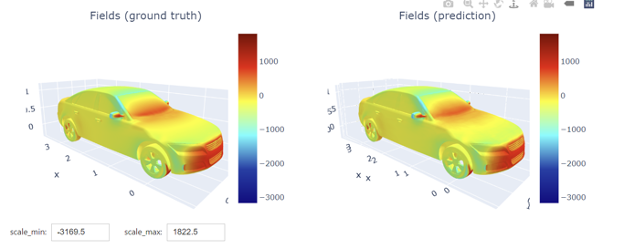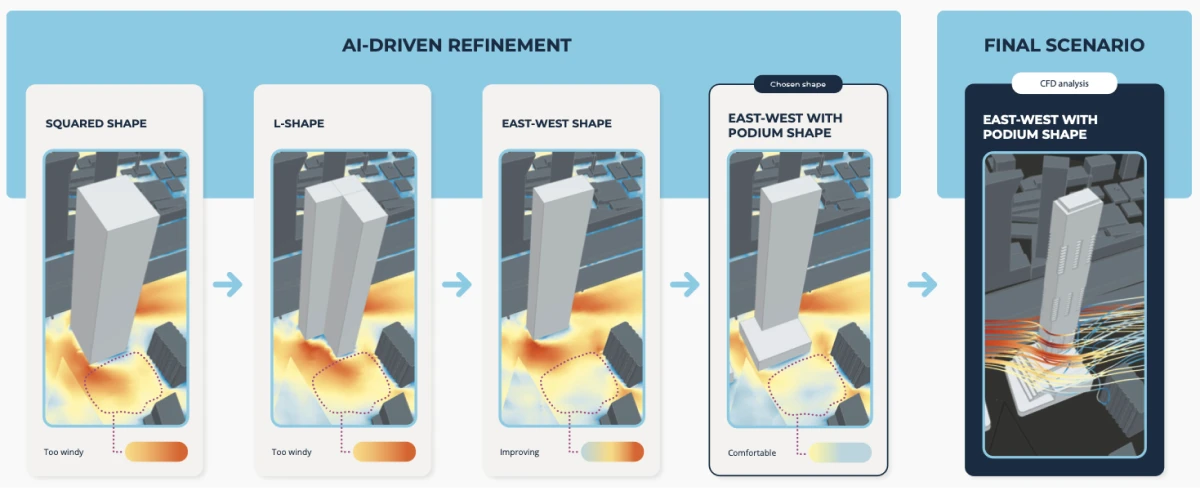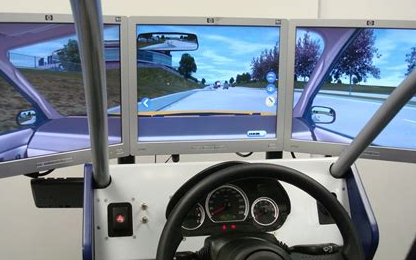AI Product Design: Benefits and Applications

Artificial Intelligence (AI) is smoothing many human activities - at home and in our jobs. In the professional world of a design team, AI can streamline tasks in product design with a predictive analytics approach. "AI product design" means a special focus on product designers' needs, integrating AI applications into their design processes to assist them in conceiving ever more successful products.
AI product design implies that product designers can carry out several tasks with the aid of Artificial Intelligence with unprecedented speed. Examples of AI product design include automating decision-making, generating new ideas for designers by proposing new concepts (generative Artificial Intelligence) - or, most commonly, fine-tune existing designs with an iterative design process within a more detailed design space.
Artificial Intelligence collaborates with consolidated methods, such as CAD technology (Computer-Aided Design, or 3D geometric modelling) and CAE (Computer-Aided Engineering, i.e. numerical analysis simulations). Those tools are already used by designers and researchers respectively. In product design, the AI revolution delivers AI-powered tools dedicated to empowering design engineers with predictive capabilities within their existing workflow - thus, designers can tap into AI-powered product designer software without having to learn anything new, since AI learns from designers.
FAQs on the AI Revolution by Experienced Designers
Before delving into general considerations, let us answer the question from designers who read articles on the AI revolution: "How can, in practice, AI tools become available to engineers?"
Quantitative data and images generated with CAD and CAE seem to be a heterogeneous lump of data that can be utilized only by specific tools such as postprocessors. However, the NC platform's Deep Learning computer vision and image recognition capabilities are conceived to produce bespoke AI product design tools that associate CAE results with CAD 3D shapes in their raw formats (for instance, IGES or STL, or native formats). Thus, Artificial intelligence can become an active part of the design process for the product designer to evaluate AI-generated proposals.
Another FAQ often coming from C-Levels concerns data security. Regarding data security, solutions like NC and advanced user research-level skills allow corporations to produce in-house AI-powered tools exclusive to the corporation owning the data.
In the following, we will explore how AI tools can be integrated into product design and the industry's benefits for the present and the future. AI tools in design are focused on present user behavior and help researchers automate repetitive tasks and . generate ideas.
Most importantly, a useful AI-powered tool like NC is deliverable as an Application Software (an App), therefore as an AI product design tool tailored to the existing product designer, leveraging human creativity in the creative process. Thus, the AI tool is an aide for innovative products, while in the background the less interesting (for designers) phase of tool construction is left to data scientists and R&D staff like advanced CAE users.
Introduction to AI
Before becoming specific on AI product design software and how it can help product designers, let us examine what type of Artificial Intelligence we mean and the AI revolution in product development across various industries. We will include the latest technological advancements, like ChatGPT.
Narrow or Weak AI
Narrow Artificial Intelligence, also known as weak Artificial Intelligence, is focused on carrying out specific tasks. Industries like automotive and aerospace are examples of industries where AI is utilized to help generate 3D spatial models of vehicles. This includes geometrical dimensions and satisfying engineering specifications: a true example of artificial intelligence engineering.
Artificial Intelligence can help designers rapidly iterate and optimize their designs. An example AI revolution in narrow AI is ChatGPT, a language model developed by OpenAI that can generate textual descriptions, instructions, and other written content and understand natural language instructions. This could aid product designers in effective communication and collaboration.
Case History - Design Process Assisted by AI
Artificial Intelligence has the potential to revolutionize product design by mimicking slow-responding simulation tools with astonishing acceleration and using this acceleration to assist human creativity.
Given a 10⁶ speed-up in response time, what are we going to do with it? The answer is: to explore 10⁶ more design changes!
Thus, combining two factors, i.e. the superfast response time and algorithmic design space exploration and optimization tools, product developers could create more innovative and sophisticated designs. Artificial Intelligence can help designers create new ideas, evaluate concepts, and optimize designs based on various parameters such as cost, performance, and aesthetics. The underlying optimization algorithms are contained in integrated plaforms such as Neural Concept's NC that strive for optimal fitness of a solution starting from a genetic represetation of the design space.
Generative Artificial Intelligence can show design alternatives and assist simulations and virtual testing to generate ideas for improved products starting from a baseline shape or "initial prompt", such as the heat exchanger in the figure.

The Deep Learning platform NC by Neural Concept platform generated the final optimized component shape as shown in the figure:

Designs produced by AI are subject both to targets and to constraints that aim to give more realistic outcomes in terms of functionality and manufacturability. However our point is not in blinding using AI in product design as a black box, but rather as a smart assistant. The question is, will AI replace engineers?
Superintelligence in AI Product Design?
Superintelligence, is a concept in which AI could surpass human intelligence in all areas, including product design. While superintelligence is still a scientific and philosophical debate, the potential implications for product design could be profound. The ethical implications of AI need to be carefully addressed.
Today, Artificial Intelligence can benefit engineers thanks to predictive analytics modeling in its weak form, which provides surrogates (predictive models) that engineers can activate on demand.
Interesting discussions on Artificial Intelligence, particularly Superintelligence, can be found on the Yann LeCun's YouTube channel.
Applications of AI Product Design Across Industries
One of the primary applications of AI product design is the automotive industry where time-to-market has shortened, while the need to reduce costs and environmental constraints have ruthlessly grown in the last years. How to produce successful products empowering designers with valuable insights?
Fortunately, big data were generated in the last decades in test labs or computer simulation departments. Those user experiences can be captured by specific tools that mimic existing workflows and are distilled in apps integrating AI product design software, thus creating a seamless transition for designers from traditional tools to data-driven AI tools.
In addition to the automotive industry, Artificial Intelligence is extensively used in other industries for product design.
An example of AI for designers is architecture and construction organizations that optimize building designs, predict structural performance, and simulate real-world scenarios.
AI in aerospace is used by designers to optimize aircraft design, reduce weight, and enhance fuel efficiency.

In all those industries, AI product design tools can augment the creative capabilities of human designers. For example, AI systems can generate design variations based on design objectives or constraints, helping designers explore different design possibilities quickly. This allows for more efficient and iterative design processes, leading to products that better meet user requirements and market demands.
AI is, therefore, transforming product design, including the latest advancements like ChatGPT. From narrow AI in CAD software to general AI for creative design assistance and the theoretical concept of super AI, the potential of AI in product design is vast. It can optimize design processes, enhance creativity, and improve product quality.
As AI continues to evolve, we expect to see more innovative and impactful applications in product design and decision-making by product designers, driving advancements and reshaping how products are conceptualized, developed, and brought to market.
How Can AI Tools Be Used for Design?
Artificial Intelligence (narrow or weak Artificial Intelligence) has been used in various industries to enhance performance and streamline processes. However, the question remains: can Artificial Intelligence be used for design? The answer is yes: even in its narrow form, Artificial Intelligence can help design systems learn from varying variables, making it an essential tool for product design.
Designers can use AI systems to consider not only the experiences that the product will experience in a specific environment but also the dynamic changes the product will undergo in response to changing conditions or user preferences in the product development process.
Advantages of Artificial Intelligence in Product Design
There are numerous benefits to using AI in product design.
Enhanced Scale and Efficiency. AI can handle vast amounts of data, expediting product development by enabling designers to access and analyze data quickly and accurately.
Core Task - Improved Design Phase. AI tools can identify potential design flaws and suggest improvements, leading to higher product design quality and reduced costs either with a fine-tuned approach or with more radical generative AI. Leveraging AI can optimize product design through intuitive user experience with a better exploration of the design space, quickly identifying flaws, and helping the product designer find inspiration to suggest improvements for optimal performance.
Cost Reduction. You can use AI to accelerate design tasks reducing the time and cost of bringing a product to market.
Using AI in the Automotive Design Process - Methods
Machine learning (ML) is a subfield of Artificial Intelligence that involves training algorithms to learn from data.
The automotive industry has been an early adopter of artificial intelligence and ML technology in product design, engineering, and manufacturing. ML methods are used during design to analyze user data and generate new designs.
Supervised Learning in Automotive Design
Supervised learning is a type of ML method where the algorithm learns from labeled data, meaning data that is already categorized or classified. This method is widely used in the automotive industry to analyze vast datasets and generate successful products that align with users' specific needs and preferences.
For example, a car manufacturer can leverage supervised learning to delve into customer feedback regarding different design principles of a car model. The algorithm can then develop innovative design concepts tailored to meet the needs expressed in the feedback, resulting in vehicles that are more in tune with customer expectations and desires.
Furthermore, supervised learning can also play a pivotal role in enhancing vehicle performance. By utilizing ML techniques, car manufacturers can analyze extensive information related to a car model's behavior across various conditions and scenarios. The algorithm can use this data to generate new concepts that have the potential to improve the car's performance under those specific conditions, leading to better overall vehicle performance and customer satisfaction.
Unsupervised Learning in Automotive Design
Unsupervised learning is an ML method in which the algorithm learns from unlabeled data. In the automotive industry, unsupervised learning analyzes user data and identifies patterns and trends that can lead to designing more successful products.
A car designer or manufacturer can use AI technology with unsupervised learning to analyze data on the usage patterns of different car models. The algorithm can identify patterns and trends that can be used to improve the design of the car models. This can lead to the development of new car models more suited to the customers' needs.
Reinforcement Learning in Automotive Design
Reinforcement learning is a machine learning method where the algorithm learns by interacting with its environment. In the automotive industry, reinforcement learning simulates different scenarios and analyzes performance data to improve the product's design. Reinforcement learning can help to simulate different driving scenarios and analyze the performance of the car model in those scenarios.
ML Transforming the Automotive Industry: a Recap
ML methods are transforming the automotive industry by improving the efficiency and quality of product design, engineering, and manufacturing processes.
As ML technology advances and becomes enriched by Deep Learning, we can expect further advancements in the automotive industry. Car manufacturers can create more efficient, high-quality, and customer-centric products by leveraging ML algorithms' power, speed, and insights.
The figure shows an example of the application of Deep Learning in the automotive industry.

Applications of Artificial Intelligence in Product Design
AI is used in various applications in product design, including Healthcare, Fashion, and Electronics.
Healthcare
Before the advent of AI, healthcare product design relied on traditional methods, which were time-consuming and lacked customization. AI has transformed healthcare product design with advanced devices and prosthetics. AI algorithms are now used to analyze medical data, such as patient records and imaging data, to design devices tailored to individual patients' needs. For example, companies are using AI to design 3D-printed prosthetics that are lightweight, comfortable, and aesthetically appealing, improving the quality of life for patients.
Fashion
Fashion designers used to depend on traditional market research and trend analysis before the AI revolution. However, these methods were subjective and time-consuming. Understanding consumer behavior and preferences required manual data collection and analysis, resulting in limited insights and generic product designs. This meant that personalized fashion recommendations were rare, leading to lower customer satisfaction and loyalty.
With the advent of Artificial Intelligence, the fashion industry is undergoing significant changes. AI is capable of analyzing vast amounts of fashion data. Data can include customer preferences, fashion trends, and social media posts. This allows for a deeper understanding of consumer behavior and design preferences. As a result, fashion designers can now create personalized and customized products that align with consumers' evolving demands.
Electronics and Smartphone Assistants
Artificial Intelligence optimizes consumer electronics product designs, such as smartphones, tablets, and wearables. It can analyze user feedback, usage patterns, and performance data to identify design flaws, improve product functionality, and enhance the user experience.
Natural Language Processing (NLP)
NLP empowers virtual assistants to comprehend and interpret both spoken and written language from users. Through the capabilities of Machine and Deep Learning, these virtual assistants continuously enhance their understanding and performance over time. They achieve this by leveraging extensive datasets to recognize speech, extract pertinent information, and produce accurate and relevant responses.
On-Board Electronics - Heat Dissipation
Furthermore, Electronics is a crucial element on the board of communication satellites. AI can provide methods for predicting heat dissipation on onboard electronics, thus making the satellite system more reliable in its crucial operations.
From Machine Learning to Deep Learning
Machine Learning and Deep Learning are two closely related sub-fields of Artificial Intelligence that have become increasingly important in recent years. ML involves training Artificial Intelligence to learn to make predictions or decisions based on past information.
Deep Learning is a more advanced technology form of ML, training artificial neural networks to recognize patterns and make decisions based on datasets.
Deep Learning learns from unstructured data, unlike traditional machine learning (ML) which requires structured data. Deep Learning is useful for image and speech recognition, voice assistants, NLP and other applications involving unstructured information.
One of the most significant advantages of Deep Learning is its ability to learn independently. While traditional machine learning algorithms require extensive feature engineering and domain expertise to be effective, Deep Learning can learn directly from data without human intervention. This makes Deep Learning particularly useful for applications without experts or where the problem domain is complex and poorly understood.

Deep learning has established itself as a leading-edge technology with a wide range of applications.
Its capacity to process unstructured data, handle massive datasets, create hierarchical representations, self-learn, and deliver exceptional performance in real-world scenarios positions it as a potent force driving ongoing advancements in the field of artificial intelligence.
Conclusion - Summary: Use AI to Conceive Successful Products
In summary, AI is already transforming product design by streamlining processes and has the potential for widespread adoption by large volumes of users.
We have shown examples of AI powerful tools enhancing human creativity while protecting data security. In use cases, AI tools provide product engineers with valuable insights they can share with their teams striving for successful products and can find inspiration, allowing designers to get more technical feedback and solve problems faster during team meetings instead of waiting for the next meeting iteration.
AI algorithms for new product designs are supporting informed decisions to create new designs and reduce costs in R&D and are attracting the attention of industry experts. Thus, it is becoming a recognized product design software, and using AI could become in the future as "normal" as using CAD or CAE.
Using AI in the product design process, either with traditional platforms or mobile apps with careful UX design mimicking existing product design software, allows designers to significantly reduce the wait time for simulations and thus the key takeaway is: "Using AI helps create products better and faster with data-driven decisions".
As the AI revolution advances, its role as a game changer in creating successful products and better user experiences will become increasingly apparent.



